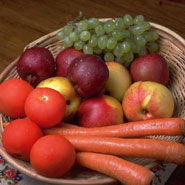Describing their findings in the journal, Evolution and Human Behavior, the team of researchers prove that eating plenty of fruit and vegetables is by far the most effective way to achieve a healthy, golden glow.
“Most people in the West think that the best way to improve your skin colour is to get a suntan,” said Dr Ian Stephen, lead researcher on the project and an ESRC post-doctoral fellow in the Department of Experimental Psychology at the University of Bristol, “but our research shows that eating lots of fruit and vegetables is actually more effective.”
The team, working at the Perception Lab at the University of St Andrews in Scotland, first assessed the skin colour of people in relation to their diet. Those who ate more portions of fruit and vegetables a day were found to have a more golden, yellow skin colour. Further analyses using a scientific instrument called a spectrophotometer measured the way that light in different parts of the spectrum is absorbed by the skin, revealing that those with a healthy glow had a higher presence of carotenoids, which are yellow and red antioxidants thought to play a role in the immune system and fertility. Carotenoids are commonly found in fruit and vegetables such as yellow and red peppers, spinach, apricots and melons.
In the second part of the study, the team used specialist computer software to manipulate the skin colour on the images of 51 faces to simulate more and less carotenoids and more and less suntan. Participants were then asked to adjust the skin colour to make the faces look as healthy as possible. Given the choice between skin colour enhanced by suntan and skin colour enhanced by carotenoids, participants preferred the carotenoid skin colour.
“Our study shows that not only do people use colour cues to judge how healthy other individuals are, but they are accurate when they make those judgements,” said Prof Perrett, who heads the Perception Lab. “This is important because evolution would favour individuals who choose to form alliances or mate with healthier individuals over unhealthy individuals.”
The study is the first to reveal such striking similarities between humans and many other species. For example, the bright yellow beaks and feathers of many birds can be thought of as adverts showing how healthy a male bird is. Females of these species prefer to mate with more brightly coloured males. This bright colouration in birds is caused by the same antioxidant carotenoids that drive the effect in humans.
“The bright yellow ornaments of birds demonstrate that the bearer has such a strong immune system and healthy reproductive system that he has plenty of these valuable antioxidant carotenoids left over to use in ornaments to advertise himself to females,” said Dr Stephen. “Our work suggests that the carotenoid colouration of human skin may represent a similar advertisement of health and fertility.”
While this study describes work in Caucasian faces, the paper also describes a study that suggests this phenomenon may exist across cultures, since similar preferences for skin yellowness were found in an African population.
The work was funded by the Biotechnology and Biological Sciences Research Council (BBSRC) and Unilever Research, and published with support from the Economic and Social Research Council (ESRC) and the British Academy.
